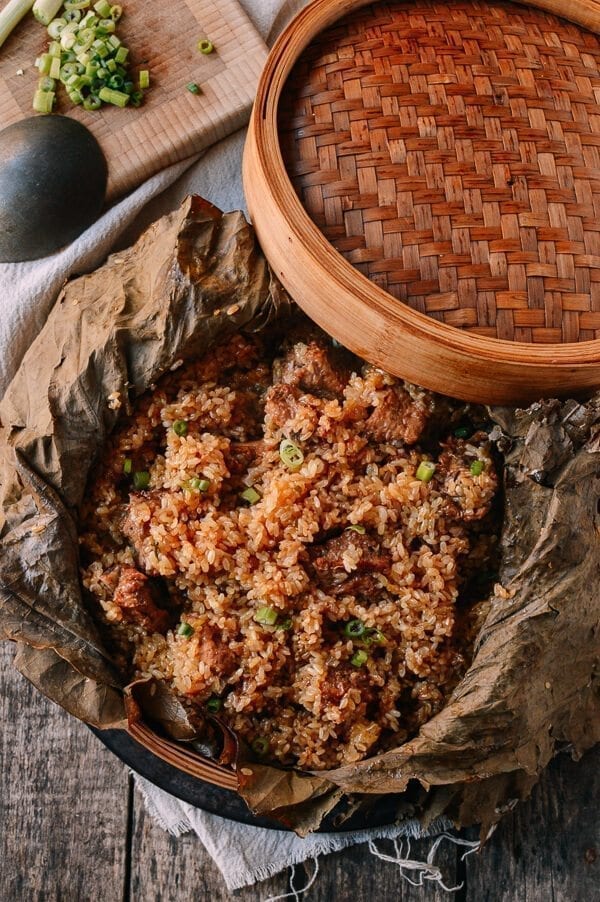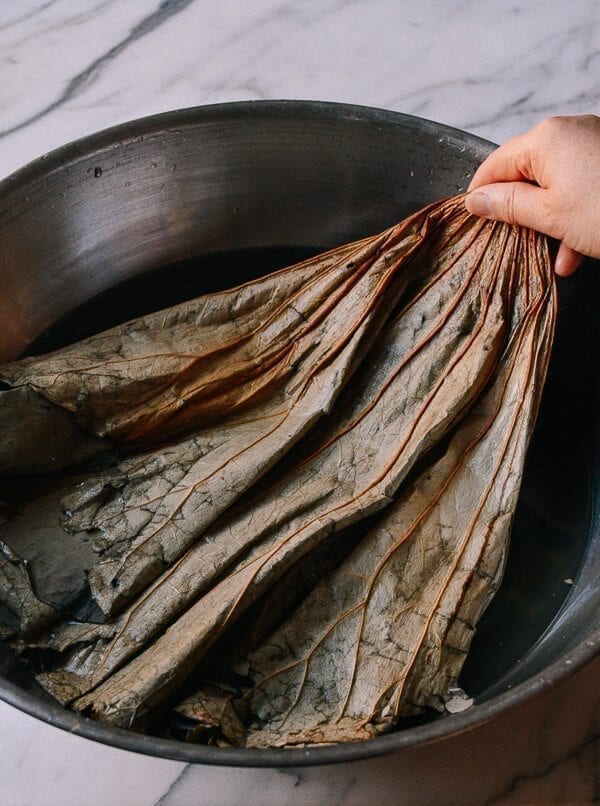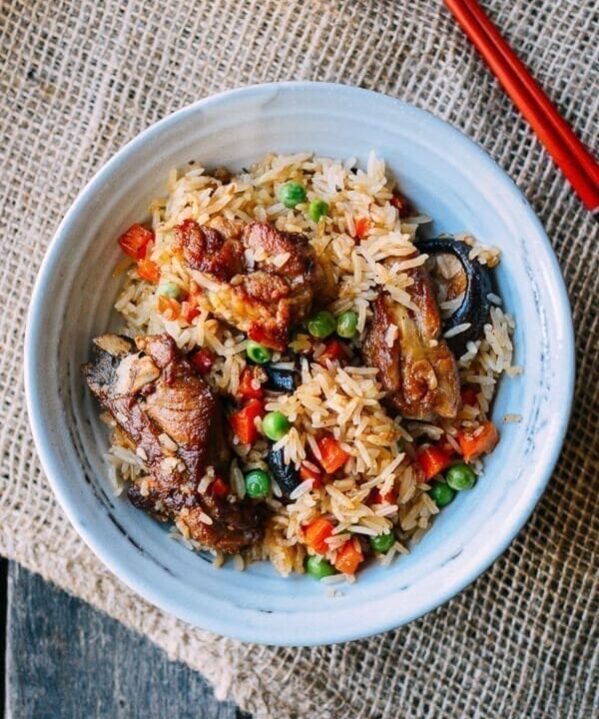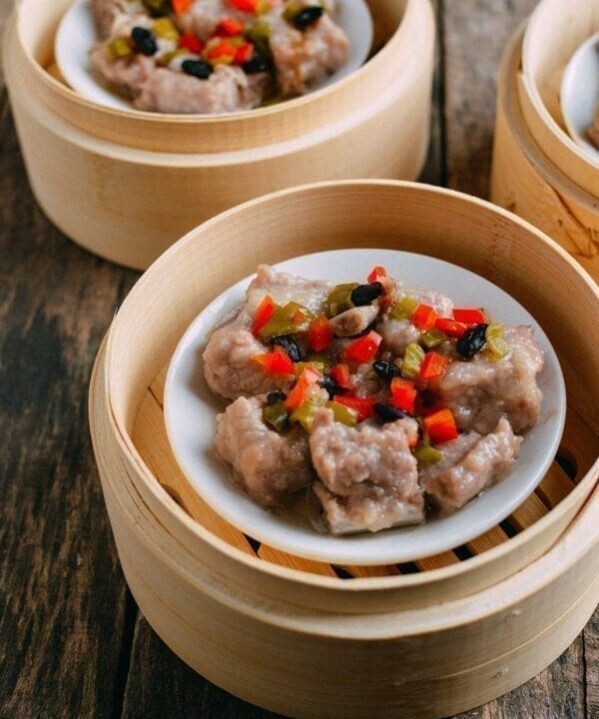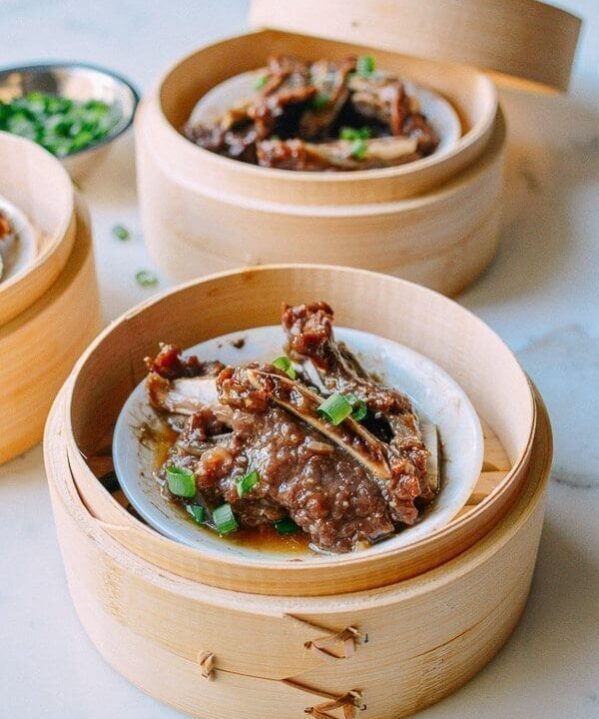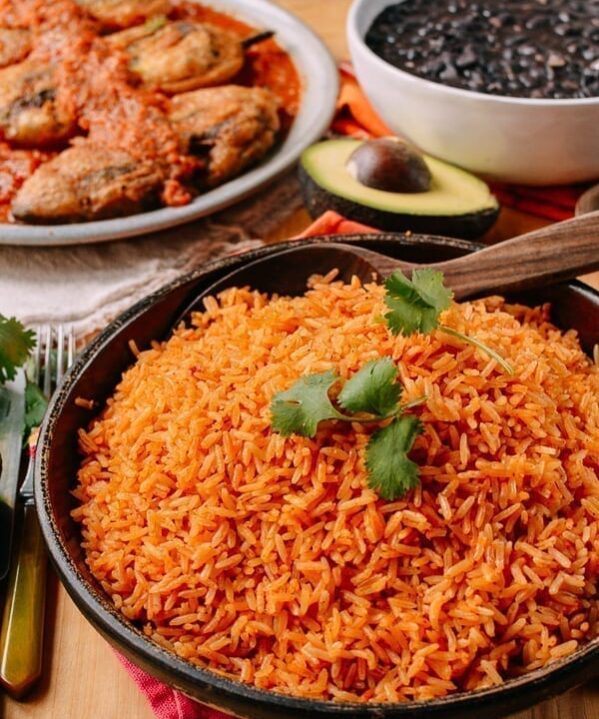Chinese New Year is right around the corner (February 16th this year), and we’re kicking things off with Steamed Ribs with Glutinous Rice or Nuòmi Zhēng Pái Gu (糯米蒸排骨). The literal translation is actually glutinous rice steamed ribs.
A *Comparatively* Easy Chinese New Year Recipe?
For the first recipe in this year’s lineup, we were aiming to make an “easy” recipe for beginners or noobs looking to wow their families or host a Chinese New Year’s eve dinner with minimal effort. But the funny thing about the food we eat during Chinese New Year is that it’s not necessarily synonymous with “easy.”
In fact, it’s about as far as it can be from easy. People go all out with intricate, delicate, and elaborate Chinese New year dishes with luxurious and “prosperous” ingredients like whole fish, chicken, shrimp, oysters, glutinous rice, lotus, etc. etc. etc.
Case in point, the other day my mom mentioned that she would cook a Chinese New Year’s Eve dinner (年夜饭) at our apartment. For the occasion, she was thinking of a very *simple* CNY menu. Nothing fancy––after all, it’s a weeknight! Here’s how the conversation went:
My mom: “Yeah I think we’ll make a simple dinner–nothing fancy. I’ll make two steamed fish…
…And hong shao rou…
…And a poached chicken…
…And two vegetable dishes–well maybe one…”
Me: (blinking rapidly and expecting her to stop talking at this point)
My mom: “…and a Yan Du Xian.” (a relatively complicated scratch-made Shanghainese soup)
REALLY SIMPLE.
So take it with a grain of salt, but these Steamed Ribs with Glutinous Rice are actually relatively easy to prepare on the spectrum of the culinary feats you can whip up for your family and guests.
There are no whole animals to deal with, and not a lot of excessive chopping or simmering. Once you get past any trepidation about using lotus leaves, all you need is a bit of overnight marinating and soaking and a reliable steamer set-up to cook the whole shebang in.
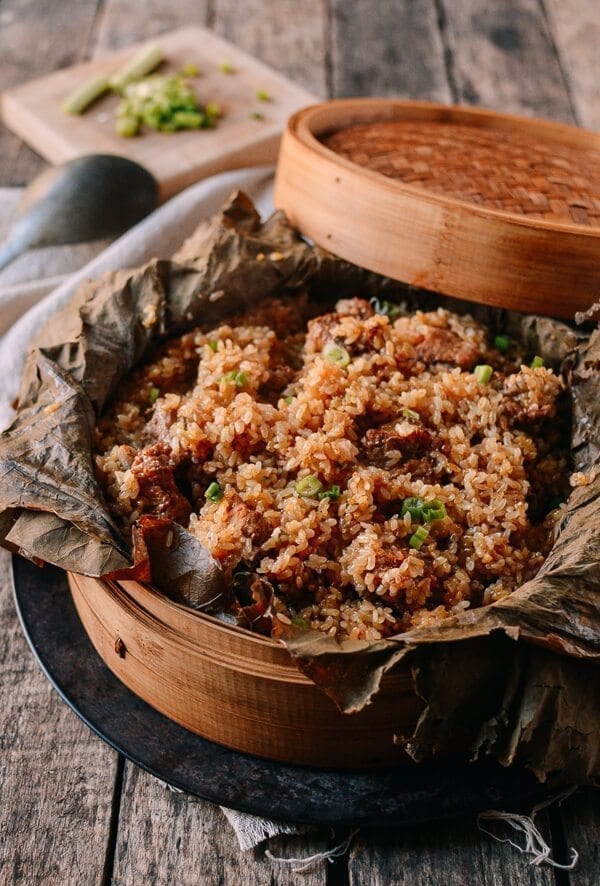
Recipe Tips
Here are a few pointers to make sure the dish is a success:
- Have your butcher cut the pork ribs if possible, since it’s very important to cut them into 2-inch pieces. If you have a Chinese cleaver, you may be able to do it yourself. See the video below.
- You can use bamboo leaves if you can’t find dried lotus leaves.
- If you don’t eat pork, a great substitute is chicken wings, cut in half at the joint connecting the drumette and the flat.
- You can also include diced potato and/or carrots in the mixture. If you are looking for a vegan option, try replacing the ribs with a meaty black mushroom.
So while Steamed Ribs with Glutinous Rice isn’t “easy” per se, it is delicious. The flavors of the lotus leaf infuse the rice and meat, and there’s plenty of umami goodness in the pork rib marinade. These steamed ribs with glutinous rice will stand up next to grandma’s “gold bar” tofu wraps, pearl meatballs coated in sticky rice, seafood bird nest, and that soup she simmered for hours. Now, let’s take this step-by-step.
Video: Cutting Pork Ribs with a Chinese Cleaver
Chinese Steamed Ribs with Sticky Rice: Recipe Instructions
The night before…
Soak the ribs for 2 hours to remove excess blood and impurities from the meat. Change the water a couple of times in between. Drain, rinse, and pat the ribs dry with a paper towel.
Marinate the ribs with the mashed red fermented bean curd, the liquid from the jar, ½ teaspoon sugar, sesame oil, Shaoxing wine, ¼ teaspoon of ground white pepper, 1 tablespoon minced ginger, and the white parts of the scallions. Cover, and let sit in the refrigerator overnight.
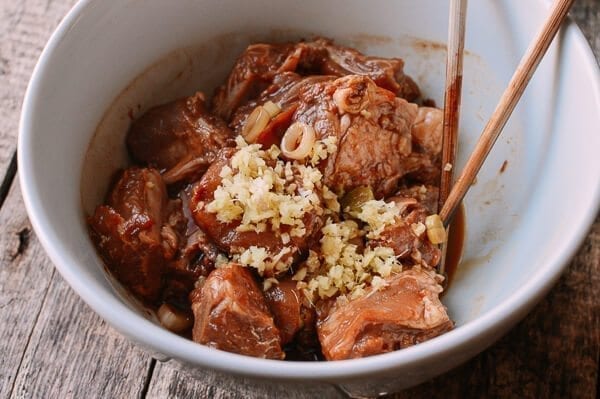
Soak a large dried lotus leaf by submerging the whole leaf under water. Use a large plate or bowl to weigh it down and leave it overnight. Handle with care, since these leaves rip easily!
The next day…
Rinse and soak 2 cups of glutinous rice for an hour, making sure the water is at least 2 inches above the rice line. At the same time, take the marinated ribs out of the refrigerator and bring them to room temperature.
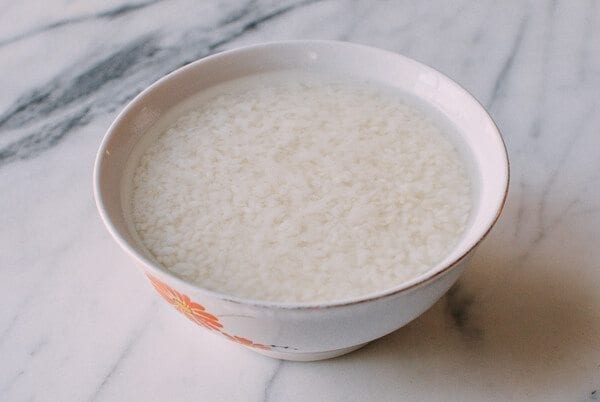
Rinse the lotus leaf front and back with fresh water. Line your bamboo steamer or large heatproof platter (with at least a 2-3 inch depth) with the lotus leaf.
Next, prepare the steamer with water. Make sure there is enough water in the steamer, but not so much that the water will flood the dish. You can always add boiling water if the water levels are low during steaming. Now cover the steamer and turn on the heat to bring the water to a boil.
Drain the soaked glutinous rice. Combine the drained rice with 1 teaspoon dark soy sauce, 3 tablespoons light soy sauce, salt, the remaining ½ teaspoon sugar, the remaining ¼ teaspoon ground white pepper, and the remaining scallions.
Now, mix in the marinated ribs (and the marinade liquid!) until well combined.
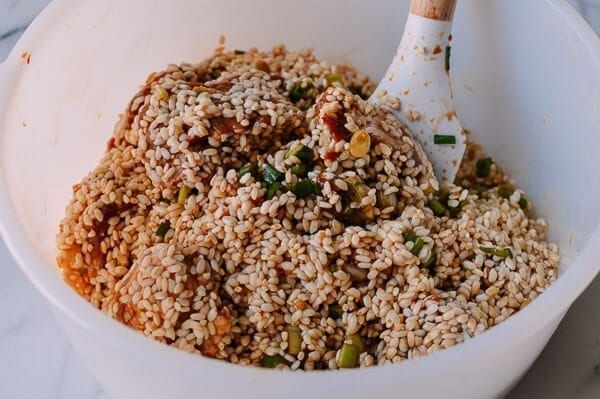
Pour onto the lotus leaf…
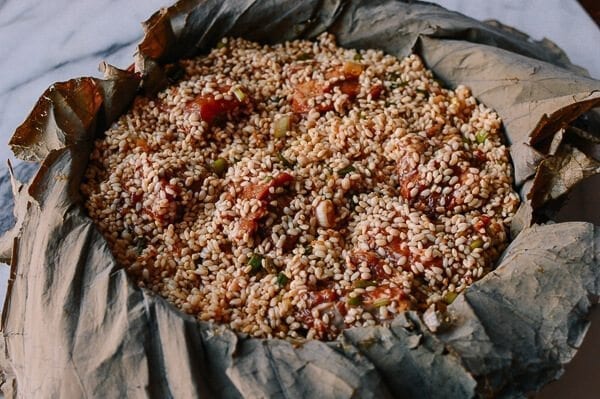
And wrap the outer edges of the leaf over the top of the rice.
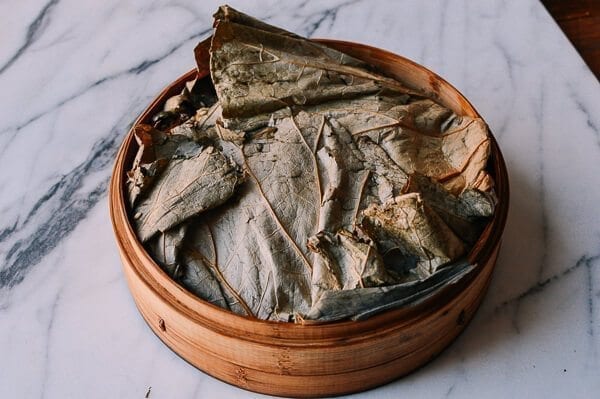
Place the whole thing carefully in the steamer, and steam for 60 minutes over high heat. See our post on how to set up a steamer if you’re not familiar with steaming foods in Chinese cooking.
Check every 10 – 15 minutes to make sure the water in the steamer does not dry out.
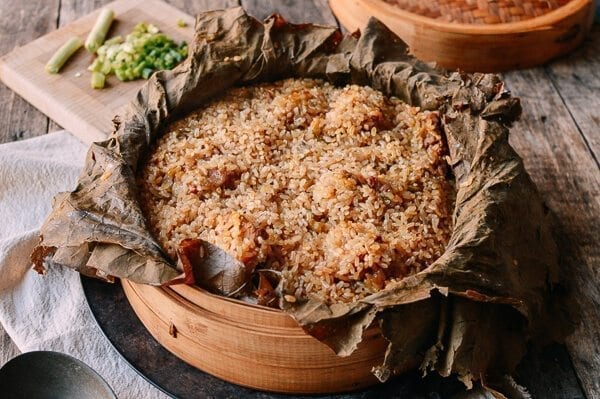
Garnish your steamed ribs and rice with additional chopped scallions if desired, and serve.
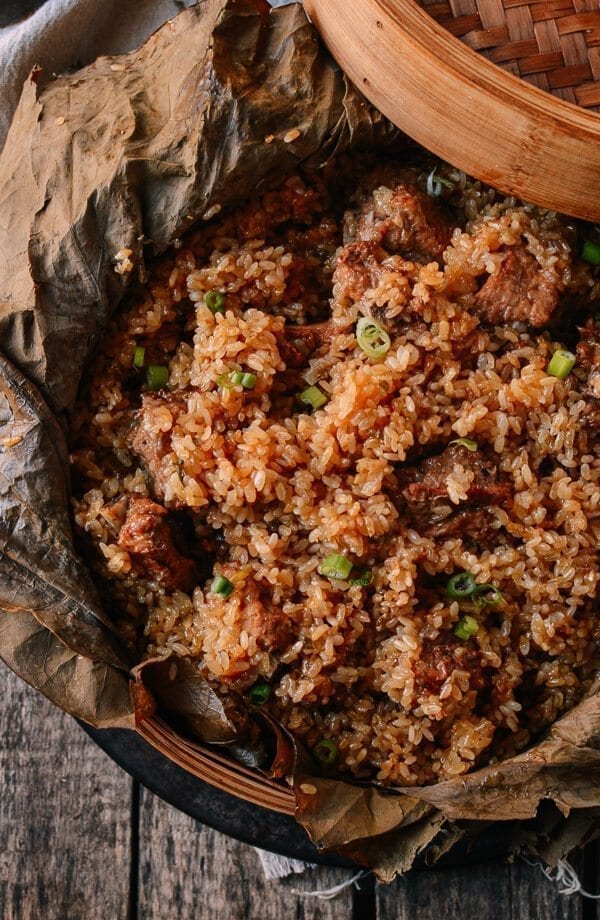
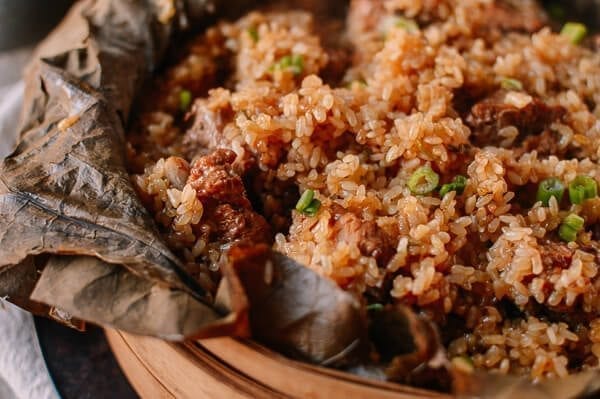
Steamed Ribs with Glutinous Rice (糯米蒸排骨)
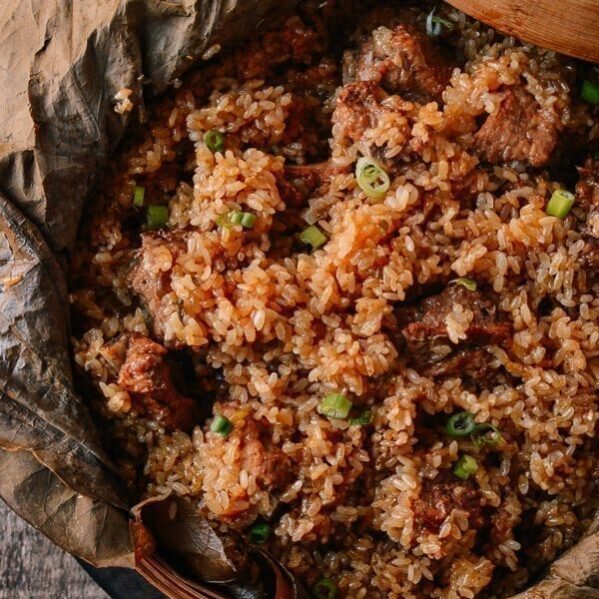
Ingredients
- 1 pound pork ribs (450g, cut into 2-inch pieces––ask your butcher or get out a heavy cleaver!)
- 1 piece red fermented bean curd (mashed)
- 1 tablespoon liquid from the red fermented bean curd jar
- 1 teaspoon sugar (divided)
- ½ teaspoon sesame oil
- 2 tablespoons Shaoxing wine
- ½ teaspoon ground white pepper (divided)
- 1 tablespoon minced ginger
- 2 scallions (finely chopped, with the white and green parts separated)
- 1 large dried lotus leaf
- 2 cups sticky rice (also called sweet rice or glutinous rice)
- 1 teaspoon dark soy sauce
- 3 tablespoons light soy sauce
- ½ teaspoon salt
Instructions
- The night before, soak the ribs for 2 hours to remove excess blood and impurities from the meat. Change the water a couple of times in between. Drain, rinse, and pat the ribs dry with a paper towel. Marinate the ribs with the mashed red fermented bean curd, the liquid from the jar, ½ teaspoon sugar, sesame oil, Shaoxing wine, ¼ teaspoon of ground white pepper, 1 tablespoon minced ginger, and the white parts of the scallions. Cover, and let sit in the refrigerator overnight.
- Soak a large dried lotus leaf by submerging the whole leaf under water. Use a large plate or bowl to weigh it down and leave it overnight. Handle with care, since these leaves rip easily!
- The next day, rinse and soak 2 cups of glutinous rice for an hour, making sure the water is at least 2 inches above the rice line. At the same time, take the marinated ribs out of the refrigerator and bring them to room temperature.
- Rinse the lotus leaf front and back with fresh water. Line your bamboo steamer or large heatproof platter (with at least a 2-3 inch depth) with the lotus leaf.
- Next, prepare the steamer with water. Make sure there is enough water in the steamer, but not so much that the water will flood the dish. You can always add boiling water if the water levels are low during steaming. Now cover the steamer and turn on the heat to bring the water to a boil.
- Drain the soaked glutinous rice. Combine the drained rice with 1 teaspoon dark soy sauce, 3 tablespoons light soy sauce, salt, the remaining ½ teaspoon sugar, the remaining ¼ teaspoon ground white pepper, and the remaining scallions.
- Now, mix in the marinated ribs (and the marinade liquid!) until well combined. Pour onto the lotus leaf, and wrap the outer edges of the leaf over the top of the rice. Place the whole thing carefully in the steamer, and steam for 60 minutes over high heat. Check every 10 – 15 minutes to make sure the water in the steamer does not dry out.
- Garnish with additional chopped scallions if desired, and serve.
